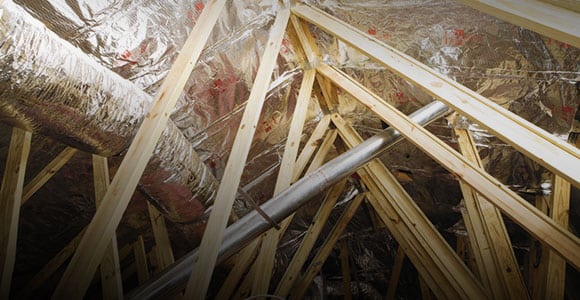Dear Jim: My air-conditioning costs were high last summer, and we still felt too warm at times. I see ads for radiant barriers that are supposed to save a lot. How does a radiant barrier work, will it save much and how much does it cost? — Ann T.
Dear Ann: Everyone has read advertisements or received sales calls about the huge energy savings from installing attic radiant barriers. The savings claimed are often the very maximum possible and are exaggerated for the typical retrofit installation. Having said that, proper installation in a specific house can yield a reasonable payback and better comfort.
The savings from installing a radiant barrier in the attic vary considerably depending on your climate and your specific house, orientation to the sun, etc. The Oak Ridge National Laboratory estimates that air-conditioning cost savings can range from about $150 annually in very hot climates to only $40 for cold climates. Attic radiant barriers provide little positive or negative effect during the heating seasons.
It is important to understand the basics of heat transfer — i.e., how a house loses and gains heat — so you can evaluate whether your home is a good candidate for radiant barriers. The most important basic is that the rate at which heat flows from a hot area to a cold one is a function of the temperature difference between the two spaces.
Conduction is heat flow through a solid object or several objects touching one another. This is how the handle on an iron skillet gets hot on the stove. The walls and ceiling of a house also lose or gain heat this way because the building materials are all nailed together.
Convection is where heat flows through a moving fluid or gas. This generally increases the rate of heat flow compared to plain conduction through a solid. An example is how your skin loses heat faster during winter when you’re in the wind. This causes the wind chill factor, creating an effective lower temperature.
Radiation is heat flow directly from one object to another through a vacuum, air, glass, etc. It is not dependent on touching or fluid flow. This is how the sun heats the Earth or you feel warm sitting in front of a raging fire.
What makes radiant energy unique is that it is much more affected by the temperature difference than the other types of heat flow. For conduction and convection, if the temperature difference between indoors and outdoors doubles, the heat flow also doubles. With radiation, the heat flow is 16 times greater when the temperature difference doubles.
This is why radiant barriers are most often used in the attic to block heat flow through the roof. On a hot summer afternoon, the temperature of a dark shingle roof can easily reach 150 degrees. This hot roof conducts heat to the roof sheathing. From there, conduction takes over the heat radiant and carries it down through the insulation, to your ceiling and into your house.
Radiant barriers require an air gap to prevent them from touching the hot surface; otherwise, they become conductors like any other building material. Reinforced aluminum foil was typically used as the radiant barrier, but now many barriers use plastic films with reflective surfaces.
In addition to reflectivity, emittance is a property of radiant barriers. It should be lower than 0.25 — 25 percent — in order to be an effective barrier. Aluminum foil is well below the 0.25 level. There also are reflective paints such as Low/Mit (www.solec.org), which can be sprayed underneath the roof sheathing. Definitely check the emittance specifications before signing any contract.
To get a good payback from the energy savings, it makes sense to install the radiant barrier yourself. Companies such as Innovative Insulation Inc. (www.radiantbarrier.com) sell double-sided reflective foil for about $130 for a 4-by-250-foot roll. Invest in a hand construction stapler, a utility knife and a long straightedge, and you are ready to install it.
The easiest method to install the radiant barrier is to cut it into lengths and staple it underneath the roof rafters. It is not important how neatly it is installed, but it is important to have adequate attic ventilation, preferably a combination of soffit and a ridge vent. When installing single-sided foil, face the reflective side down to take advantage of its low emittance.
Have a question for Jim?
Send inquiries to James Dulley, The Tennessee Magazine, 6906 Royalgreen Drive, Cincinnati, OH 45244, or visit www.dulley.com.



